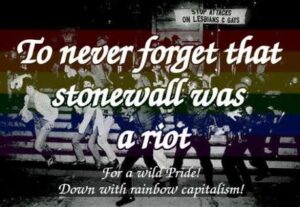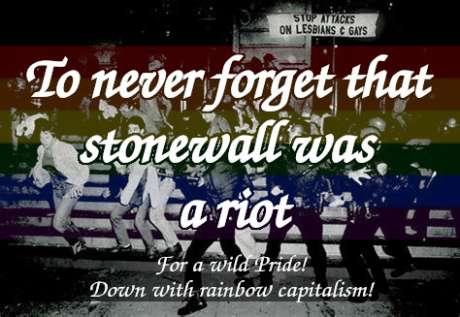“We as LGBTI peoples cannot free ourselves, no oppressed peoples can. So how and why will others come to our defense? And whome shall we, as queers, fight to defend? We should be the best fighters of each others oppression-and in doing so we will build links of solidarity, in doing so we will forge an invincible movement against all forms of justice and inequality”
– Leslie Feinberg
The first wave of the modern Queer struggle began in 1865 and lasted until 1935. This movement rose from the larger struggle of German workers to win the most basic democratic rights. In the German workers’ struggle, LGBT comrades were in the lead. This tradition of LGBT comrades taking their places within the many struggles of the people has continued ever since. In 2013, during the Gezi uprising, people again witnessed the powerful solidarity of LGBT comrades as they fought on the barricades and helped hide people from the police.
Our rich and complex histories are often left out, minimized and erased. They are part of our roots, a part of the long history of queer uprising and solidarity and in the fight against patriarchy and the heterosexist system. Today, many conservative as well as liberal currents try to claim gender identities outside the cis-binary and sexual orientations outside of heterosexuality as something new. They either frame it as something external that threatens the established rigid social order or they draw pride from efforts of integrating further and further categories of identities into the existing legal frame by granting rights.
But Queerness is nothing new at all. Ascribing victories of LGTBI* rights to liberalism is absurd, considering history. Various sexual orientations and gender expressions are as old as humanity. The ancient goddess Inanna, also known as Ishtar or Astarte, got rescued by the two sexless beings GalaTura and KuraGarra. Greek mythology encompasses hermaphrodites, beings who are female and male at the same time and carry characteristics of both. Indian Kamasutra and history is full of accounts of homosexual and other sexual practices. In Hindu religions there are goddess/gods who change their gender or have several genders. Indigenous cultures have a plenitude of understandings of gender and sexuality, commonly having a conception of a third and a fourth gender. Despite being heavily oppressed and suppressed, traces of those are still present all over the world. In fact, the normality was that there was not one ‘normal’ rigid line of gender categories.
What actually was imported from the Global North to other parts of the world, were moral laws and enforcement by colonial powers. The British empire for example exported their idea of Christian heterosexuality to their colonies. They outlawed various expressions and sexual practices declaring them as sodomy. For colonialists, women were just producers of the ‘raw material’ slaves, while men were just an exploitable labor resource. By limiting sexuality to heterosexual reproduction, colonialists made humans into objects that are easier to control.
The logic of patriarchy enforces a hierarchy of ‘man’ over ‘woman’. It cannot do this without first dividing humans into the categories of ‘man’ and ‘woman’ and denying that genders outside the cis-binary ever existed. Homophobia is also a tool for patriarchy to maintain an idea of a strict moral code that focuses on the reproductive and controllable role of women, denying the role of desire or pleasure.
In this, the oppression of women and queers are inextricably intertwined, if experienced in different forms though. Queer resistance is not an attack towards women’s resistance, it inevitably is fighting patriarchy too. Both are part of a greater struggle that defies the subordination of any people on base of their gender or sexual orientation and challenges at the same time the social constructions of the patriarchal system defining what is a man, the norm of the world, and what is not.
Heteronormative patriarchy enabled and legitimised an entire frame of the male heterosexual white norm, the cis-het-man who thinks logically, makes contracts, owns everything he can grasp, rules others, decides alone what is right and wrong, defines categories where everybody else is less than him and puts people in these boxes. He does not shy away from any form of violence to put his worldview into practice. This violent symbol of a man is what we are killing together.
Today, as we celebrate the anniversary of an uprising against one aspect of these systems, we see that progress is not a guarantee, and that liberation does not come from one uprising alone. During the Arab Spring, there was also hope for new freedoms for LGBT people and for women. Many of these hopes were broken by violent oppression from fascists. In the Middle East, in Europe, and across the world, different types of fascists are waging a war to force people into classic roles of sex and gender even more harshly than before. One of their methods is spreading homophobia, transphobia, and misogyny. Trying to make us into enemies of each other is an old tactic of theirs. We fight against this by declaring that our Queer solidarity is with the women’s liberation struggle, and it always has been.
Let’s join our hands around the triggers of our weapons, let’s break together the narrative of patriarchal categorisation, let’s smash the arrogant ownership of land and women. We shatter the institutions the violent man has built, shoot a bullet into the violent man’s heart and plant seeds of flowers into the hole, so regenerated humans of love can grow from it. Standing here, we are joining an ancient string, simultaneity and repetition of women’s and queer resistance. Let’s affect the course of history right here right now, remembering the long and rich history of trans, queer and homosexual struggle that fights for life in all its fuller and more faceted forms!

Note about words: LGBT or LGBTI (Lesbian, Gay, Bisexual, Transgender, Intersex), Queer, Gay, and other words are used often to describe a category of identities, bodies, and behaviors that fall outside society’s narrow conventions about sex and gender. As society changes, the meanings of these words change and often the words themselves go out of fashion and new ones develop. When we use these words it doesn’t mean we are making another box, another scientific category. It means we find something in common between our experience inside and beyond gender’s borders. In the future, the words we use today may no longer be the right ones, and this statement will seem backwards or ignorant. We welcome this, because it will mean we have traveled further towards total liberation.

